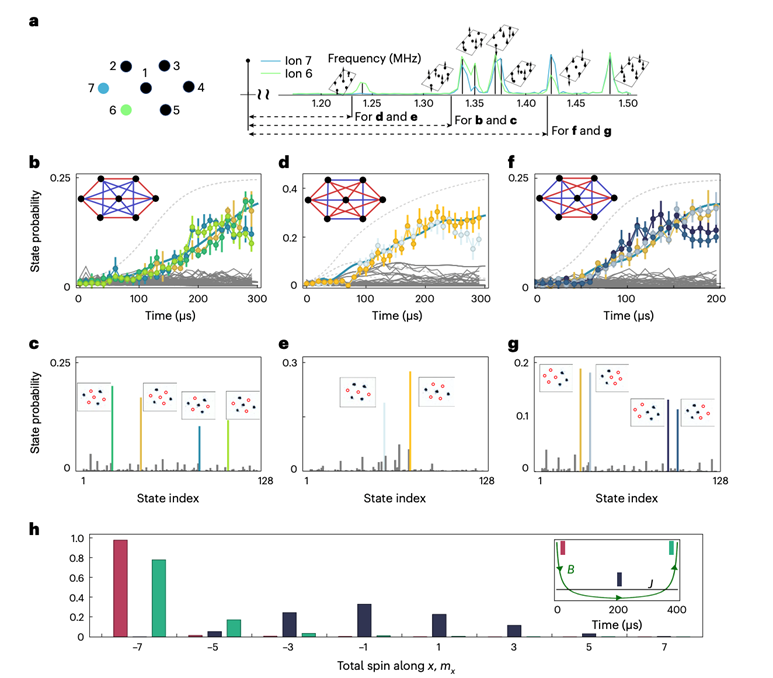The research group led by Prof. Kihwan Kim has made progress in the research of ion trap phononic computing
2024/02/01
The ion trap system is one of the leading platforms in quantum information research, which has long coherence times and high-fidelity quantum gates, and is used in quantum computing and simulation. However, most ion trap quantum information processing experiments are currently performed on one-dimensional ion chains. Two-dimensional ion crystals can significantly enhance the scalability of ion trap systems and enable the exploration of novel two-dimensional quantum physics. Over the past decade, research groups globally have proposed several ideas to expand ion traps into two dimensions but have been hindered by issues such as micromotion.

Figure 1. (a) Schematic diagram of the ion trap chip structure. (b) Scanning electron microscope image of the ion trap chip. (c) The ion trap chip assembled in the vacuum chamber.
Recently, a research team led by Professor Kihwan Kim from the Department of Physics at Tsinghua University / Beijing Academy of Quantum Information Sciences proved for the first time that two-dimensional ion crystals in a Paul trap can be utilized for quantum information processing. This study is based on the team's self-developed ion trap chip that confines a two-dimensional ion crystal. They cooled Yb171+ ions to fewer than one phonon using electromagnetically induced transparency. Quantum simulation experiments were then conducted on two-dimensional ion crystals consisting of 4, 7, and 10 ions. By adiabatically reducing the transverse magnetic field strength, the ground state of the Ising model was successfully prepared.
The research team first rotated the ion crystal by controlling the voltage of the chip electrodes, aligning micromotion perpendicular to the operating laser. This arrangement prevents decoherence caused by the micromotion on the laser, allowing for high-quality quantum operations. To achieve this, the team designed an ion trap chip that can precisely adjust the angle of the ion crystal, demonstrated for the first time in 2020.

Figure 2. (a) The vibrational spectrum of a two-dimensional ion crystal composed of 7 ions. (b,c,f,g) The ground state with frustrated interactions prepared by adjusting the detuning, with (b,f) showing the adiabatic evolution curves, and (c,g) showing the ground state populations. (d,e) The adiabatic evolution curves and ground state populations for the ground state with partitioned magnetization. (h) The initial state is prepared by reversing adiabatic evolution to verify quantum coherence.
The team conducted quantum simulation experiments on a two-dimensional ion crystal comprising four ions to validate the quantum simulation's ground state. Researchers used the center-of-mass mode and the zig-zag mode of the ion crystal for adiabatic evolution simulation. They measured the adiabatic evolution's time-evolution curve and final state population. The researchers found that the quantum state obtained after adiabatic evolution matched theoretical expectations. In the center-of-mass mode, a ground state with ferromagnetic interactions was achieved, with all spins tending in the same direction. In the zig-zag mode, an antiferromagnetic interaction ground state was achieved, with adjacent spins tending in opposite directions, verifying the reliability of the adiabatic evolution process.
The researchers then tuned the interactions within a seven-ion two-dimensional crystal by changing the detuning, achieving ground states with frustration and partitioned magnetization. They successfully prepared the ground state through adiabatic evolution, demonstrating the adjustability of two-dimensional ion crystals for quantum simulation. Additionally, the researchers used reverse adiabatic evolution to evolve the prepared ground state back to the initial state. The high overlap with the initial state, which had not undergone adiabatic evolution, confirmed the quantum coherence of the entire process.
This work was published on January 26, 2024, under the title " Tunable quantum simulation of spin models with a two-dimensional ion crystal." in Nature Physics. The Corresponding authors of the paper are Mu Qiao and Prof. Kihwan Kim from Tsinghua University. The first author of the paper is Mu Qiao. Authors included Associate Research Scientist Jingning Zhang, Assistant Research Scientist Pengfei Wang. The work was supported by the innovation Program for Quantum
Science and Technology and the National Natural Science Foundation of China.
Link to the full article: https://www.nature.com/articles/s41567-023-02378-9
 中文
中文 Email
Email QCloud
QCloud Log in
Log in
